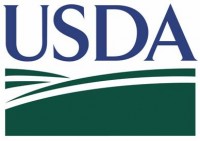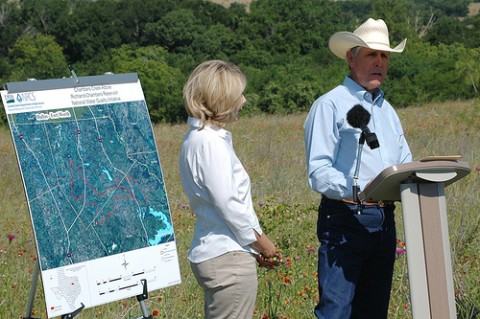By Dave White, Chief of the Natural Resources Conservation Service (NRCS)
 Washington, DC – How important is water? Well, it’s not a question I have to think too hard about. What I can tell you is that without it, there wouldn’t be any humans or critters roaming the earth.
Washington, DC – How important is water? Well, it’s not a question I have to think too hard about. What I can tell you is that without it, there wouldn’t be any humans or critters roaming the earth.
In the U.S., we use a little more than 400 billion gallons of water a day. According to the UN, in the worldwide picture about one in five people lack access to a clean, improved water source.

- Gary, right, and Sue Price have been implementing conservation practices for more than 35 years they on their “77 Ranch” and they have submitted an application for the new national water quality initiative.
At USDA’s Natural Resources Conservation Service (NRCS) we view clean water as a top priority. Every day, our employees work with farmers and ranchers to improve on-farm water management—using a systems approach to avoid, control and trap pollutants.
The type of pollutants we are working to control, through our conservation actions or “practices” are farm waste, fertilizer, sediments, pesticides and herbicides. Our goal is to stop these at or before the edge of a field, so they don’t run into the water. And that’s why we recently created the National Water Quality Initiative.
We launched the National Water Quality Initiative with $33 million dedicated for farmers and ranchers, with financial assistance for any size agriculture operation to help reduce the loss of excess nutrients and sediments from their fields. We expect to show how the actions of farmers and ranchers can remove a stream from the impaired list.
When large numbers of farmers take action together in one area, in one watershed, it can make a difference—it can stop an algae bloom or keep bacteria from reaching a drinking water source. And clean water is absolutely critical for the freshwater ecosystems that 44,000 aquatic species call home.
In Texas, ranchers Gary and Sue Price have been working with NRCS and the Navarro Soil and Water Conservation District for over 35 years to implement conservation practices on their ranch which lies in the Trinity River Basin—an area that provides water for over 40 percent of Texans.
The Prices began addressing water quality several years ago when they converted a portion of their cropland to a wetland. Wetlands are the clean water sponges, or kidneys, of the land. They minimize soil erosion and are excellent wildlife habitat. The couple also installed a riparian buffer with native plants. This buffer acts as a filter while creating habitat for both bobwhite quail and Rio Grande turkey.

- A pasture on Gary Price’s 20,000 acre “77 Ranch” which is located within a watershed that provides drinking water for over 40 percent of Texas’ population.
A pasture on Gary Price’s 20,000 acre “77 Ranch” which is located within a watershed that provides drinking water for over 40 percent of Texas’ population.
If you are a farmer, rancher or forest landowner interested in signing up, you can check a map online and see if you are located in a priority area. If you prefer the in-person route, we have USDA service centers in almost every county, and you are always welcome to stop in and complete an application. Applications must be submitted by June 15, 2012 in order to be considered for this fiscal year’s funding opportunity.
Since the White House Rural Council was established last June, the Council has provided a forum for increasing conservation work and creating jobs in rural America. Through the National Water Quality Initiative, we will have measurable progress achieved with support from the Rural Council.
Follow NRCS on Twitter.

